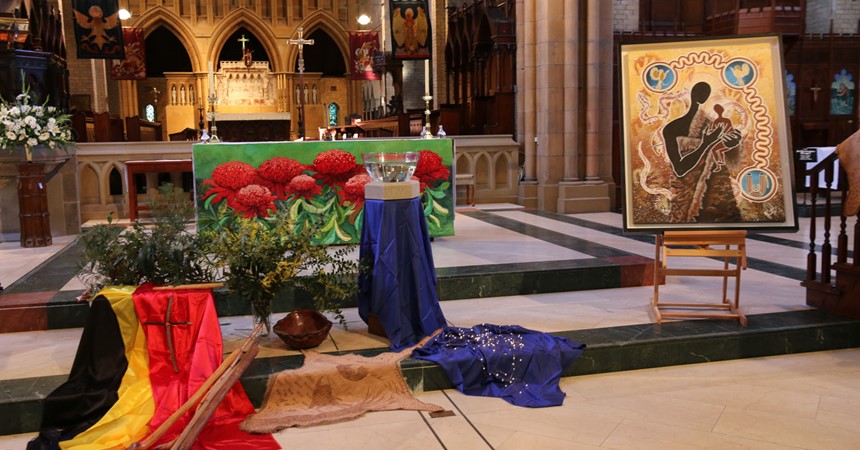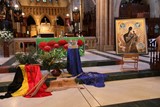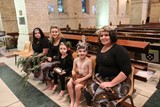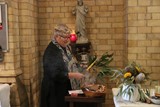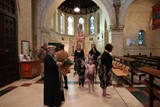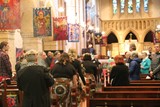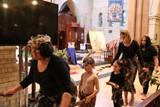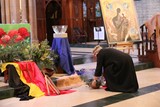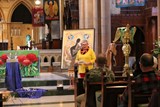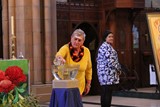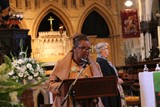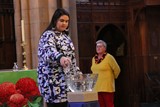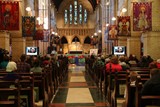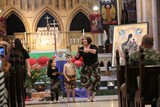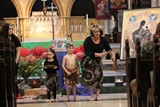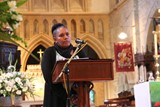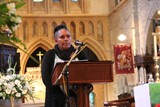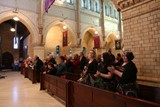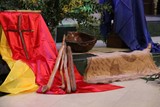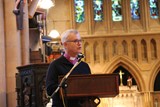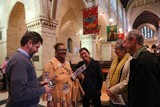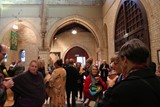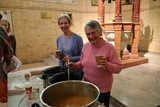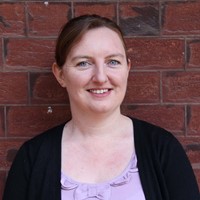Reflecting the week’s theme - Because of her, we can! which is a celebration of the contribution that many indigenous women have made to our communities - the service started with a traditional smoking ceremony.
Rev Di Langham led the way, carrying in the smoking leaves with a procession of dancers.
The service started with Worimi/Awabakal woman Julie Perry reading the Welcome To Country.
Emblems and Blessings
An icon of Mary and Jesus by Catholic indigenous artist Richard Campbell was displayed in front of the altar together with a variety emblems - a kangaroo skin, a coolamon, a digging stick, a candle and a rugged cross.
The kangaroo skin reminds the indigenous of Byamee, creator and eternity. The coolamon represents mothers who nurture children and provide food. A digging stick is a symbol of the work of women. The candle brings to mind women that have gone to be with their ancestors. Finally, the rugged cross shows that Jesus came to live as one of us in poverty and oppression.
The Four Winds blessing was read as water was poured in turn into a communal bowl. The congregation faced each different direction as they heard the words of the blessing:
“Let us face east. The symbol of the east is the magpie, which announces the coming of the sun at dawn. It symbolises the good news and a new day dawning. Jesus is our morning star.
“Let us face south. The symbol of the south is the emu. A bird that tracks the land and searches with intense curiosity. The south represents truth from within. In searching one’s experience and culture, one discovers the tracks of God in our past and present.
“Let us face north. The symbol of the north is the kangaroo. It is a national symbol of uniqueness and strength, endurance and abundance.
“Let us face the west. The kookaburra sings the sun to rest. It flies true and straight, sure of its purpose and goal. The west represents strength and energy for the people.”
Aunty Brenda’s story of being stolen from her family
Aunty Brenda Mathews then spoke of how she was taken from her family in 1973 when she was three years old.
She recalled how she spent five years with a white family after welfare wrongly accused her father of being an alcoholic and her mother a single mum of seven children. Before being taken away, Brenda would play with her siblings and run to greet her father daily when he returned home from work.
“Between 1909 and 1969 it was the assimilation policy,” she said. “This is what they call the Stolen Generation. I was removed in 1973 and brought back in 1977. The Act changed, but the action didn’t…it was all still part of the same horror movie.”
After being removed from her birth family and taken to a new, white family, she was removed again after five years - something that was very traumatic for Brenda. She had created bonds with her new family which were suddenly broken when she lost contact with her white family. To make matters worse she received no help in transitioning from her white family back to her birth family.
It took 40 long years before she saw her foster parents - this was after searching for them on Facebook where she discovered that her foster sister had died.
Aunty Brenda’s moving talk led to a standing ovation from the congregation.
The service ended with prayers, a blessing and the sharing of a meal. Certainly a stirring and moving start to the week.
